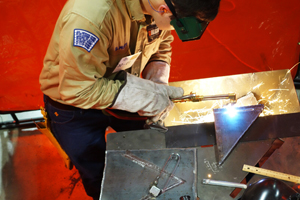
Brandon Moore has an unusual job for someone with a degree in philosophy. A graduate of the University of Central Missouri, Moore works as a welder for Jacobs Field Services, a contractor at an ExxonMobil refinery in Baytown, Texas. Although he says he enjoyed his time in college, he questions the market value of his education and wonders what might have happened had he spent four years traveling the world instead of grinding away over the works of Plato, Nietzsche and Kant.
As it is, Moore is doing as well or better than many recent graduates, a sizable percentage of whom are unemployed or underemployed, according to the Federal Reserve Bank of New York. With overtime, Moore earns more than $40,000 annually, and his company is paying for his welding apprenticeship classes. He envisions the day when he’ll make $100,000 a year or more as a skilled craftsman in a high-demand field.
With those kinds of prospects, along with the spiraling cost of higher education and an uncertain job outlook for university grads, a growing number of young people are bypassing four-year colleges and opting for trade schools and apprenticeships.
The U.S. Dept. of Education reports that sub-baccalaureate certificates such as associate’s degrees awarded in construction, manufacturing and transportation jumped by 67.8% from 2000 to 2012, compared with 46.6% growth in four-year college enrollment during the same period.
“We are seeing enormous amounts of interest and excitement about postsecondary career and technical education among students, particularly ones who have been enrolled in career and technical education in high school or have worked closely with their career and guidance counselor to identify the field of study that they’re particularly passionate about,” says Sean Lynch, spokesman for the Association for Career and Technical Education (ACTE), an organization of approximately 23,000 secondary-school and postsecondary vocational teachers and guidance counselors.
Once viewed as the country cousin of universities and high school college-track programs, career and technical education (CTE) is gaining prestige, especially as schools combine it with core academic subjects such as algebra and geometry. Often fostered by trade groups, career-education “academies” are springing up within high schools across the nation. According to Lynch, they bear little resemblance to the voc-ed programs of the past.
“There’s this notion that CTE students are working in this industrial-revolution-era classroom at the back of the school,” Lynch says. “And these programs are anything but that. They’re typically founded in STEM [science, technology, engineering and math] education principles. They teach employability skills [for example, teamwork and interpersonal relations] that we hear consistently that employers are looking for and are having challenges finding. And they teach students this curriculum in fields that are quickly growing, everything from IT to energy production, agriculture, food and natural resources—anything you can think of, there’s a CTE path for it, and it really can benefit any student.”
Career and technical education has long been a staple of community colleges, which offer a path to work as well as credits that can transfer to a four-year college. Many community colleges now offer dual-enrollment programs with high schools, in which students take CTE classes at their local two-year college while pursuing their regular secondary studies. Job-placement rates can be quite high; Foothill College in Northern California’s Silicon Valley last December reported 100% success for students in its electrical, plumbing, ironworking and sheet-metal apprenticeship programs.
Muranda Lomas, 19, is excited about her prospects as a recent graduate of Blackhawk Technical College (BTC), a two-year school in Janesville, Wis. A member of a car-racing family, Lomas was always interested in welding and earned a one-year certificate in the trade from BTC. She recently began work as a welder with a local farm-implements manufacturer and will earn back the $8,000 to $10,000 she spent on her schooling within a few months. Her verdict on her educational choice: “I wouldn’t trade it for anything in the world.”
Even Harvard University endorses this paradigm. In a widely publicized 2011 paper called “Pathways to Prosperity,” Harvard researchers William C. Symonds, Robert Schwartz and Ronald F. Ferguson argue that “College for all does not mean that everyone needs a B.A.” They note that only 33% of jobs require a bachelor’s degree, and observe that “a young person of whatever background who leaves community college after completing a one-year occupational certificate program ... may earn more than many students who complete a four-year degree program.”
Still, some worry that CTE will—as they argue it has in the past—become a vehicle to divert minorities and economically disadvantaged students from the dream of a four-year college education.
“Nobody who spends much time in America’s high schools could possibly argue that they are focused on college for all, or ever have been,” Kati Haycock, president of The Education Trust, was quoted as saying in the Huffington Post in response to the Harvard paper. “Most schools still resist that idea, instead continuing long-standing, unfair practices of sorting and selecting like an educational caste system—directing countless young people, especially low-income students and students of color, away from college-prep courses and from seeing themselves as ‘college material.’”
“I agree with her that it’s something we have to be careful about,” says Stephen DeWitt, ACTE deputy executive director. “What I don’t want to see is people just shutting the door and saying that’s a reason we shouldn’t have career education or we shouldn’t support these programs. What we’d really like to see is all students have some type of career and technical education.”
Mallory Stevens, CTE Transitions program director at Cañada College, a two-year institution in California, says many of her co-enrolled high-school students initially don’t think of themselves as candidates for higher education but then flourish and return for additional studies, frequently after working for a couple of years.
One craft professional who took both the college and apprenticeship route is Russell Johnson, an estimator with Watson Electrical Construction Co. in Raleigh, N.C. Johnson, 31, started his career with Watson after attending East Carolina University for a year, until—as he jokes—“East Carolina decided I didn’t need to be there anymore.” After spending two years in Watson’s apprenticeship program, Johnson finished his degree in construction management at ECU, then eventually returned to Watson and completed his apprenticeship.
Johnson appreciates his education, but nonetheless finds it largely irrelevant to his work. He also acknowledges that he could have reached his current position simply by completing his company’s own construction management program.
“What they teach in school is very broad,” he says. “It’s mostly just for general contractors—this is how you estimate, this is how you schedule. It’s very theoretical. So you have general contractors now who have no clue, in my opinion, about what’s going on in the job because they’ve never had that real hands-on experience—this is how you solder a weld, this is how you rough in a conduit.”
As for the economic value of college, Johnson points to a recent performance he saw with actor John Ratzenberger, perhaps better known as the character Cliff Clavin in the TV comedy “Cheers.” Johnson recalls Ratzenberger telling the audience about speaking at a high-school commencement where the college-bound graduates were ribbing a classmate who had chosen mechanic’s school.
“He told those kids, ‘When you’re done with college—if you finish—you’re going to have a pile of debt. Your friend is going to spend two years to become a mechanic. And while you’re waiting tables because you can’t find a better job, you’re going to be paying him to work on your car.’” Moreover, that kid may someday operate his own car-repair shop, just as an apprentice could eventually run a construction firm.



Post a comment to this article
Report Abusive Comment